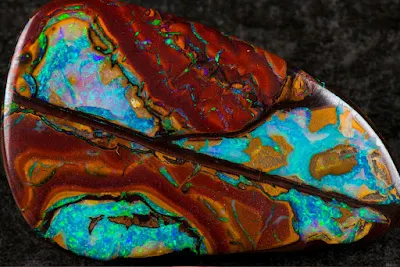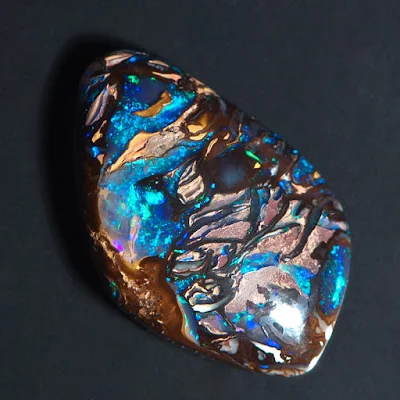Types of Opal With Photos
Opals come in various types, each with its own unique characteristics. Opal is a hydrated amorphous form of silica SiO₂·nH₂O; its water content may range from 3 to 21% by weight, but is usually between 6 and 10%. Due to its amorphous property, it is classified as a mineraloid, unlike crystalline forms of silica, which are considered minerals. It is deposited at a relatively low temperature and may occur in the fissures of almost any kind of rock, being most commonly found with limonite, sandstone, rhyolite, marl, and basalt. Opal is the national gemstone of Australia.
The variety of natural opal is determined by the two characteristics of body tone and transparency.
Body Tone - The base tones of light, dark and black opal range from colourless, white, through the various shades of grey, to black.
Transparency - Opal of any body colour will be opaque, translucent or transparent. When it is transparent or very translucent, and the colour clarity is sharp, it is often referred to as crystal opal.
Types and varieties of Opal
There are two main types of opal: precious opal and common opal.
Precious opal is the most valuable type of opal. It has a high concentration of silica spheres, which gives it a brilliant play of color. Precious opals are typically found in black or dark-colored matrix, which helps to enhance their color.
Common opal does not have a high concentration of silica spheres, so it does not have a play of color. Common opals are typically found in light-colored matrix, and they are often used in jewelry and other decorative items.
Within the two main types of opal, there are many different varieties. Some of the most popular varieties of opal include:
There are black opal, white opal, crystal opal, jelly opal, fire opal, hyalite, water opal, pink opal, hydrophane and honey opal.
.webp) |
| Types of Opal With Photos |
Read also: Opal Patterns with Photos
Precious Opal
Precious opal is the most valuable type of opal and has a high concentration of silica spheres, which gives it a brilliant play of color. Precious opals are typically found in black or dark-colored matrix, which helps to enhance their color. Some of the most popular varieties of precious opal include:
Black Opal
 |
| Natural Black Opal Credit : Nur Rachman Effendi |
Black Opal is the rarest and most valuable type of opal, known for its dark body tone that highlights its vibrant play of color. Primarily found in Lightning Ridge, Australia, where unique geological conditions contribute to their formation. High quality stones are very rare. The term 'black opal' does not mean that the stone is completely black (a common mistake), it simply means the stone has a dark body tone in comparison to a white opal. Easily distinguished by the blackness of the background "body tone" or body color. The black body tone is caused by trace elements of iron oxide and carbon. Highly sought-after by collectors and jewelry designers due to their rarity and beauty.
White Opals
 |
| White opal |
White opals are the most common type of opal. White opal is more common and because of its body tone, generally does not show the color as well as black opal. They are typically lighter in color than black opals, ranging from white to cream to light gray. White opals can also exhibit play-of-color, but it is usually less intense than that seen in black opals. White opals are found in many locations around the world, including Australia, Ethiopia, and Mexico.
Boulder Opal
 |
| Boulder opal |
Boulder opal is a variety of precious opal that has the host rock forming naturally as part of the gem. Often just a thin vein of precious opal is present. It mainly occurs in specific locations over a wide area of Western Queensland. Boulder opal occurs as in-fillings of cracks or voids usually in ironstone boulders. Boulder opal can be black or light depending on the appearance of the stone when viewed from the surface. Boulder Opal has a tendency to cleave; when cleaved the "split" leaves two faces of opal, with a naturally polished face.
Fire Opal
 |
| Incredible Fire Opal From Mexico. Credit: Opalinda.com |
Fire opal is a transparent to translucent opal, with warm body colors of yellow to orange to red. Although it does not usually show any play of color, occasionally a stone will exhibit bright green flashes. The Fire opal is a term not commonly used within Australia but most famous source of fire opals is the state of Querétaro in Mexico; these opals are commonly called Mexican fire opals. Fire opals that do not show play of color are sometimes referred to as jelly opals. Mexican opals are sometimes cut in their ryholitic host material if it is hard enough to allow cutting and polishing. This type of Mexican opal is referred to as a Cantera opal. Also, a type of opal from Mexico, referred to as Mexican water opal, is a colorless opal which exhibits either a bluish or golden internal sheen.
Matrix Opal
 |
| Matrix opal, From Queensland Australia |
The term matrix opal is commonly used where the opal is intimately diffused as infillings of pores or holes between grains of the host rock in which it was formed. Boulder matrix opal is found in Queensland and can be distinguished by the ironstone host rock.
Andamooka matrix opal is a porous material from Andamooka,South Australia, Which may be enhanced by soaking the specimen in a sugar solution and then boiling in acid to deposit carbon in the available pore spaces, resulting in a dark background.
Common Opal
These don't exhibit play-of-color but come in various colors and forms, including:
Hyalite
 |
| Hyalite, from Megyaszó (Hungary). Copyright: Stone Ásványfotós |
Hyalite or Mullers Glass, is a colourless opal which gives the appearance of glass. Rarely, it does display a faint tint of colour (blue, green or yellow). It is also sometimes referred to as water opal, too, when it is from Mexico. The two most notable locations of this type of opal are Oregon and Mexico.
Girasol opal is a type of hyalite opal that exhibits a bluish glow or sheen that follows the light source around.
Hydrophane Opal
 |
| Hydrophane opal. Photo: James St. John |
Hydrophane opals are opals that have a higher porosity and will absorb water, when in contact. You can easily spot a hydrophane opal because when placed in water, they will become transparent and their colors subdued.When dry, hydrophane opal can be opaque or milky-white. But when immersed in water, it becomes transparent or translucent, revealing its true colors and patterns. This characteristic gives it the name "hydrophane," which means "water-loving" in Greek. It is often used in jewelry and other decorative items.
Peruvian opal
 |
| Stunning Blue Green Peruvian Opal Photo : © Trudi Unsworth |
Peruvian opal is a type of opal that is found in the Andes Mountains of Peru. It can come in a variety of colors, including pink, blue, green, and yellow. Peruvian opal is often matrix opal, which means that it is opal that is mixed with other minerals such as ironstone or sandstone.
Honey Opal
 |
| Bright honey opal from hungary |
Honey opal refers to a variety of opal with a yellow, orange, or brown body color. It can be translucent or clear and have a resinous to glassy appearance. It may or may not have play-of-colour. Honey opal is found in various locations around the world, including Australia, Ethiopia, Mexico, and the United States.
Jelly opal - Water opal
 |
| Photo: Opal Trove |
The jelly opal, also known as the water opal, is a unique opal variety that has a gelatinous appearance. The jelly movement across the jelly opal gemstone body resembles the flow of water, which is likely behind the stone’s alternate name, “water opal.” Jelly opals get their gelatinous appearance from a couple of features: thickness and transparency. It is found in Mexico and Ethiopia.
Pink opal
Pink opal is a type of opal that has a pink color. It can be found in a
variety of shades, from light pink to deep rose. Pink opal is often
found in Australia, Peru and Ethiopia. It can be transparent,
translucent, or opaque. Pink opal is often used in jewelry, but it can
be delicate and should be protected from water and harsh chemicals.
Synthetic opal
 |
White Gilson Snythetic Opals
|
Opals of all varieties have been synthesized experimentally and commercially. The discovery of the ordered sphere structure of precious opal led to its synthesis by Pierre Gilson in 1974. The resulting material is distinguishable from natural opal by its regularity; under magnification, the patches of color are seen to be arranged in a "lizard skin" or "chicken wire" pattern. Furthermore, synthetic opals do not fluoresce under ultraviolet light. Synthetics are also generally lower in density and are often highly porous.
Doublet Opals: Opals that are made by gluing a thin layer of opal to a backing of another material, such as black glass or obsidian. Doublet opals are less expensive than solid opals, but they are not as durable.
Triplet Opals: Opals that are made by gluing a thin layer of opal to a backing of another material, such as black glass or obsidian, and then covering the top with a layer of clear glass or plastic. Triplet opals are less expensive than solid opals, but they are not as durable as doublet opals.
Natural opal photos
 |
| Stunning Mexican Fire Opal looks like a beautiful sunset in the clouds or a fiery explosion with billowing smoke. Photo: Jeff Schultz |
 |
| The Eagle Opal - 50 carat contra luz precious opal from Oregon, USA |
 |
| Outstanding Rough Opal From Oregon, United States. |
 |
| The Oregon Opal with the Ocean inside Credit: Mckenna Praetorius |
 |
| Oregon Contra Luz Opal with botryoidal Jasper inclusions, from Oregon |
Understanding the different types of opals allows enthusiasts and collectors to appreciate the diversity and beauty of these unique gemstones. Each type possesses its own charm, making opals a fascinating and varied category in the world of gemstones.











